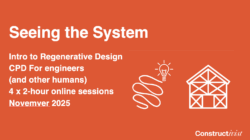Yesterday we kicked off our new introduction to regenerative design, ‘Seeing the System’.
The premise is simple: seeing more clearly the systems we are working with as a precursor to changing them for the better.
The system of drawing plans, mining materials, fabricating components, pouring foundations and assembling all these elements to create buildings and infrastructure — the system we call construction — is currently wired to cause net harm.
Yes we create buildings, yes these buildings for the most part are beneficial, but the side-effects are major contributors to climate change and ecological destruction.
To understand why, we have to see the system.
- What kind of systems are we dealing with?
- What are the feedback loops that reinforce the way the system works?
- How is the system organised?
- How do materials and energy flow?
- What is the system optimised for?
What are the mindsets that govern our behaviour as well as our dreams?
Then we can start to ask what if that system were different? What if every time we built something, the places that were touched by that process were better off? Habitats enriched, communities enhanced — all through the act of design and construction. That’s the goal of regenerative design.
Seeing the system helps us to interpret this dream, compare it to reality and then help us figure out what step to take next.
We’ll be running another edition of Seeing the System in the spring — stay tuned for more info.
-
Seeing the System — a systems led intro to regenerative design
Price range: £150.00 through £350.00


